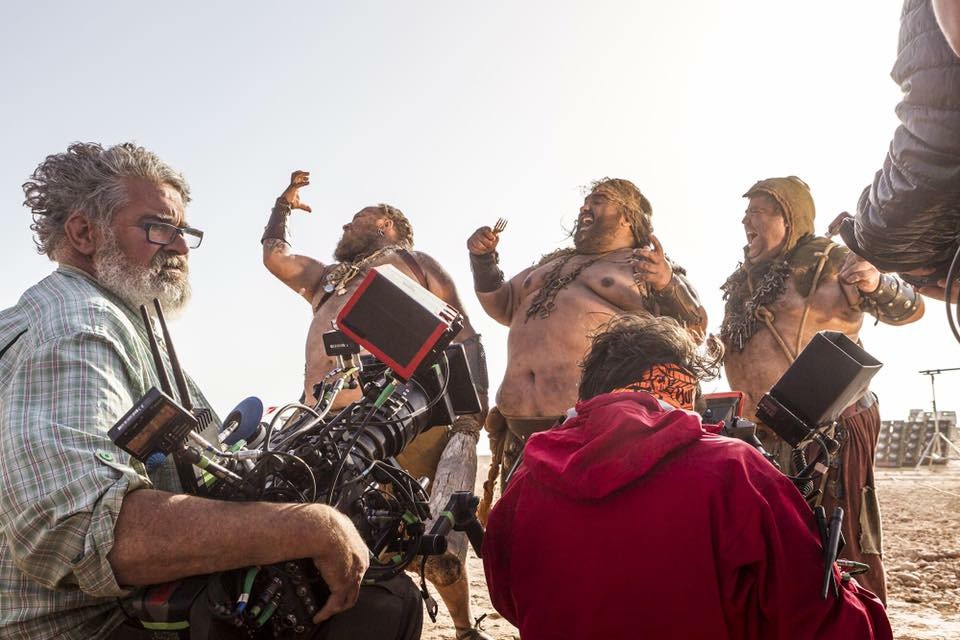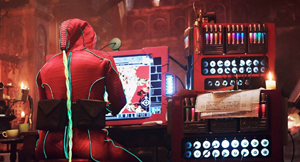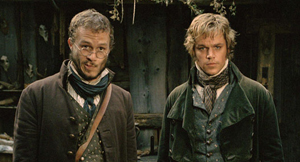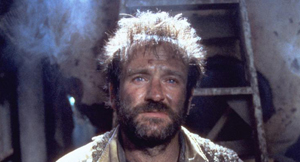In March 2018, Terry Gilliam spoke to Phil Stubbs about finally completing his Quixote project. This was ahead of the picture’s world premiere at Cannes. The purpose of the interview was to provide Phil with information and quotes for the picture’s production notes.
This is the third interview with Gilliam about this incarnation of The Man Who Killed Don Quixote. A first interview with the director, dated February 2017, on location in Portugal is available here. Also there is a second interview during postproduction, conducted in September 2017.

Phil Stubbs: You’ve finished the movie – there’s nothing else to do on it
Terry Gilliam: Nope. But there’s a lot to do now unfortunately, we’re now getting it out to the world. That’s the next phase.
Do you feel exhausted at the end of postproduction?
Yep, because it’s just gone on so long, so many things… there’s always the normal problems, but there were just more this time. And I am completely exhausted.
Could you tell me about Rossy de Palma on set?
Rossy de Palma is a star. She’s a bit eccentric, and she’s very good at being Rossy. And she likes the camera pointing at her. So we had a good time pointing it at her. She’s quick, she’s fast. The camera really loves her, she has a great presence, she’s funny. Whatever you need, she can do it. She and Sergi López make a wonderful couple.
What did Sergi bring to his role?
Sergi is incredibly funny, that’s what’s great about him. Funnier than I expected him to be. He’s funny and dangerous – he’s just a great actor, he’s just a ball to work with. He’s got all of this energy, he grabs hold of the moment and makes it work. And he can spin on a dime from being terrifying to pathetic, and that’s perfect for the part.
Hovik, how did you find him, and how he was in his role?
I needed a big strong man to be Raúl, who runs the bar and is the father of Angelica. Camilla, who is the Spanish casting director, said you should meet Hovik, he’s an ex-boxing champ. He’s Armenian, he’s got everything going for him. He’s big and powerful, but he’s incredibly sensitive. A great father figure to have around. You know you’re protected, you know you’re cared for. You know he loves you. His timing is, like almost every other actor in this, exquisite. That’s what’s on this film – everybody I’ve cast commands the screen when it’s their moment. It’s hard to imagine anybody else doing these characters, once you’ve seen it.
Putting aside the Canary Island tax money, why did you choose Fuerteventura?
Originally we went to both Gran Canaria and Fuerteventura… Fuerteventura is very bleak. There’s no greenery there. There’s beautiful mountains but nothing that is vibrant other than just rocks – they’re very vibrant if the sun hits them properly. Especially in the morning and the afternoon, it’s absolutely gorgeous. Strangely enough when we got there, of course, the dust was blowing in from Africa, so half the time we couldn’t see the mountains. Nature was having fun, as nature can do.
Were there any specific problems that you had in Fuerteventura?
It was just that the weather was not helping us, and what should have been more beautiful mountains lit by the sun didn’t quite happen. It’s still very striking and barren. I wanted it to be like that. In some ways it’s less beautiful, but it’s still very strong. There’s a great contrast to Navarra where it’s green and lush… and you turn round the corner, and you’re into a desert. That works really well. The great thing also is it’s all volcanic, so there’s this incredible geothermal structures that are no longer thermal. They’re just big and black and dangerous. And there’s moments when it’s almost like a strange dragon in the landscape, but it’s just the way the earth has been ripped apart by lava and volcanic eruptions. So it’s fascinating for those reasons.

I saw a picture on Facebook of a big blue foot…
That big blue foot is there to represent a giant’s foot. You don’t see the blue foot in the film because it’s replaced by a real giant’s foot. There’s a joke about the big blue foot which we carved and sent down there because it was the wrong foot. It was supposed to be the left foot, but it’s a right foot. But nevertheless in the finished film it works as a basis for Adam to leap up on and pierce with his sword. That worked, but at the time I thought – this is madness. It’s come all this way in this big container to handle this huge foot. We get it down there, and it’s the wrong foot!
Any stories to tell about filming the giants in Fuerteventura?
No, it was all very straightforward, trying to get the camera low enough and then you shoot like that. The guys were great, they just went for it. All three of them, they had a great time doing it. It was all very straightforward, except for the shortage of time. We were rushing, trying to get the shots quickly and that’s where we had problems with focus.

You went to Castillo de Viñuelas. That’s a hotel now and you used it for the hotel lobby scenes as well as the rooms?
Yes, we did it all there. In fact, the bedroom is the same room used twice, with a bit of redressing. We also found a corridor in the back of the service area that we used for the rather smart corridor outside of the boss’s room. We got away with that. The hotel actually has quite a history: Franco lived there. In the main room that we used for the restaurant, we built a big baldecchino in the middle, where the flamenco dancing and the troupe perform.
You built a big what?
A baldecchino. You’ve got to use the word baldecchino. It’s an Italian word, if you go into St Peter’s in Rome you’ll find one at the altar. Four columns with a top on it, usually sitting over something sacred or special. We built one to dance under, and unfortunately, the way we shot it, you don’t see all the incredible beautiful work on the top of it. A waste of money!
Was it constructed by Benjamín and dressed by Edou?
No, this one was all Benjamín. It was a really nice thing. He built all this Perspex to light through, and we didn’t do it that way in the end. In the big hotel in the restaurant area, there’s a whole bar that’s all backlit. That was all built in front of windows because we were shooting in the day time so we had to black everything out.
Anything interesting happened at the Castillo?
Not really, it was just too late in the shoot to have interesting stories!
At the end of the shoot you were in Madrid in the studio
We shot most of the giants stuff out in Fuerteventura. In Madrid, we were just picking up bits, with the focus. It’s very hard because you’re taking a normal sized human being and trying to make them a giant. The one thing you’ve got to get right is the depth of field, because something as big as a giant, everything would be in focus. When it’s small, it’s hard to do. So there were several things in Fuerteventura in the rush, we were a little soft, so we were shooting those details at the end, such as putting the camera into one of the giants’ mouths, things like that. Most of the stuff we were doing at the end… there was blue screen work, with Adam being slung around by giants.
Moving into postproduction – was it tough or easy?
It’s been nine months – that’s a long time for postproduction. It normally lasts six months. It just went on and on. There were delays with the special effects. When we put the inn sequence back in, we had quite a few effects shots we needed there, we really didn’t have time to play anymore, so we ended up using a company in Bulgaria.
I tried to keep the special effects simple, and that’s just what it was. The giants sequence in the end, it works very well. Because the speed at which we shot it, the focus problems, it’s simpler than I originally wrote it, but at that point in the film it’s probably good to keep it simple. But in the end it works. What I did like is how we can take one location and turn it into several different places, just by changing the distant background.
What were the editing challenges?
Everything was fairly straightforward. The problem is when you are cutting and waiting for special effects, it’s always difficult to judge whether you are cutting too tightly, because until the shot is finished, you can only imagine how much more information is in the shot. Working with bluescreen, always the difficulty is trying to judge that. We were having to wait until we had a finished shot, or least until we had enough detail where we could say OK that’s cut too tight, or cut too loosely. But we had these constant schedules where we had to deliver for various reasons what appeared to be a finished film.
So we would rush to get something done, or rush to get it done so Roque had something to put the music on, or write the music for, and then you’d find… the final shot is in here, it’s too short, we’ve got to extend it. Now, can Roque or Graham Sutton, the music editor, find a way of extending the music? So there was a lot of that going on.
We had to go back to Belgium, to Brussels, to finish off the final dub of the movie because when we were there, we were originally scheduled to be there for three weeks and finish the dub, but on the last day, the entire desk decided to crash and there was no way to get the thing started again! So we had to come back a few weeks later to finish it again. The curse of Quixote kept appearing!
Was there any data lost when the desk collapsed?
No just the whole thing just said, that’s it, I’m not doing any more work. Just stopped, and we couldn’t get it going. They had an insurance policy, they had a company that’s supposed to be 24 hours available to get there and fix it, and the company didn’t pick up its phone. So there was no way we could get the thing up and running. So we had to come back to London, wait a couple of weeks, until everything is back up and running, they could fit us into their schedule again. And we then finished it, yeah.
I spoke to Roque a few weeks ago, he was very happy with his work on the project
He’s brilliant, he’s absolutely brilliant.
He was telling me about the unusual instruments used on the soundtrack
He’s very big on finding odd strange, medieval, ethnic instruments, he just has a great ear for interesting sounds. We wanted that, because we wanted a sense of something that is foreign, exotic and mysterious in many places, and he didn’t use normal, familiar kinds of instruments that would deliver an obvious reassuring sound. We wanted to worry people a bit more.
The great strength about his music is he writes really beautiful romantic music. It’s never sentimental, it’s never cheap, and it’s just beautiful. I really feel lucky to have got him. A Spaniard who also can write for big movies. That kind of spirit is very rare. He’s just got a huge heart, and he’s very smart at the same time. If you’ve got a big heart and you’re smart you can do really interesting romantic music, never getting cheap and sentimental.
One thing that Roque said was important that the music reflects the truth of what Quixote sees, or seeing the world from Quixote’s perspective
Yes, that’s the whole thing. It’s so easy in movies to impose what you think people will be feeling, yet we were trying to be true to Quixote. Be honest no matter how crazy he is. Whatever he is experiencing, it’s got to be genuine. Quixote doesn’t lie, he doesn’t fake what he’s experiencing. We felt that was very important. George Fenton saw the movie, at an early stage when we just had some temporary music from Roque on, and he said yes, it’s got to be honest, whatever you do. You have to be true and honest. Because there’s so many cheats you can do in music to enhance things too much. It’s what I don’t like about Spielberg movies, they use the music to manipulate the audience.
Tell me how the inn sequence with Rossy & Sergi managed to get back in the film?
When we did the first viewing of the first assembly of all the material, I hated it. I thought – what a crap film we’ve made, it was just really bad. And the only thing really I felt strong about was the love story between Angelica and Toby, that was the one that really held my interest in the first assembled cut. And I felt that things like the inn scene were from a different kind of movie, more like a Terry Gilliam movie, and it just seemed to delay the love story. I just said, it’s out, got to get rid of that. I was like this through the whole cut, all the way through our screenings right until the last minute.
One of the things that made me hesitate was I had written this letter to Sergi and to Rossy saying, how respective of how wonderful they are, how much I love them, unfortunately I’ve cut them out of the movie. I was about to send the letter, and I kept hesitating, and then Teresa Font who was the Spanish editor, she had done a new cut of the scene, and cut it down to half its original length, maybe even less than half, and it had been sitting on my computer and I’d refused to look at it for a month or two. I said: no, no, it’s not going back here, the scene is out. I really wanted to get the film working well, before I even consider the possibility.
I was literally about to send the letter to Sergi and Rossy and I said I’d just better look at what Teresa did. And there it was – a really shortened version and it works. I then chopped a few more bits out of it, some of the funniest bits when we had written that scene I just chopped out because there was no need for them. Go to the inn, get certain things done… The other thing that had been niggling me was that there are several key things in that scene that provide clarity to what happens later – Malambrino, enchanters, all of that. These were important things.
And then there were these really good performances. A great one from Laura the dumpy girl on the bike, who was so funny, and Sergi and Rossy of course. This was really good material and I was throwing it all away. I couldn’t do it. So I didn’t send the letters and we put it back in, and everybody loves it. The other thing – from our screenings, comments from people were saying: I wish there were more adventures between Toby and Quixote. And this was a really good adventure so we put the gypsy back in, really good stuff between Toby and Quixote, and Malambrino the enchanter.
What we did musically was use stuff from other cues, and they all work. This is where Graham Sutton, our music editor, is absolutely brilliant. He’s a genius because when he had to do a temporary score, Roque had sent to him about 10 CDs of all different films he’s done, all the music. And Graham just dived into that and made the temp score so wonderful. At one point I was saying to Roque, don’t be frightened to copy yourself, the temp score is so good. Don’t sit and try to write new stuff. Just copy yourself!

Do you identify with Toby or Javier the most, or both?
I identify with both of them in different ways. I wish I was as smart, good looking and talented as Adam is, and the same goes for Jonathan. These guys have brought such life and honesty and comedy to the characters. They’re fantastic. Toby is a guy who is still tempted by Hollywood. I identify in the sense that I have never done it, but I’ve certainly been tempted to. It’s a story of punishing a guy for betraying his talents. I’m very aware of the moments when I have compromised. I know how it feels. So all of those things I understand, and the guilt.
Actually I don’t feel guilty, that’s a lie. I don’t feel guilty about having gone to all these places in the world to make films, and fucked up, or turned people’s lives upside down. I don’t feel guilty, but that is part of the theme.
A lot of both characters is a way I imagine I could be if I compromised more, or didn’t compromise as much as I compromised. One is much purer than the other. The madness of Quixote is very pure, Toby is much more a real person. Even with Quixote, what we emphasise is Quixote’s pride that gets out of control. He becomes arrogant and he is humiliated, ultimately, by believing too much in his world view, the world he sees.
It’s a moral tale for all sorts of people: how you are punished, how you must be careful of how far you fly and how low you fall. You’ve got to find a path through it. I think that’s… I can’t remember whose agent saw it, she didn’t even see the finished film, and she said she walked away on pink clouds. Now that’s a great review from somebody, that’s in a sense what we do with people.
When I think about it, it’s become very much about the world we’re living in. This sexual predatory behaviour, it’s not a Harvey Weinstein figure, it’s a woman! It’s Jacqui. All sorts of things played around with, without ever being preachy.
When one movie executive saw it, he said he thought it was so about the world we live in right now. It’s quite nice to hear that from somebody. There’s only one shot that I regret not keeping in, you might have seen it in the earlier cut, when Jacqui and Toby walk out of the restaurant, and as they’re walking out, she grabs his ass, and he discreetly pulls her hand away. We cut it, because we didn’t need it, and there was a better cut. But I wish it was back in, just to make that statement.
To what extent has Spain and Spanish culture been an inspiration?
It’s always there, when you’re in Spain. One thing is Spanish pride, which is a big thing. Pride always comes before the fall. I like that, you see a certain sense of honour. I think that’s what’s nice about working with a Spanish crew. I’m not asking to make it more Spanish, just trying to be honest to the world we’re working in. If something seems too American, or seems too British, you pull back from it.
Quixote is very much associated with Castillian Spanish, but you had so many people working on the picture who were Catalans, including Teresa, Sergi, Jordi, Els Comediants. Did you reflect on that or have conversations that the Catalans were taking over?
It didn’t divide the crew or any of that stuff. We’re all pretty intelligent. It depended on what was going on… the Madrid government were just being ruthlessly ridiculous, but on the other hand the Catalan politicians are just asking for it. Confrontations back and forth. When we were mixing in Brussels, it was amazing there because the Catalan prime minister was in Brussels, and in the streets around us there were all these Catalans with the big flags. And Theresa May was trying to negotiate her Brexit. So everywhere there was madness.
Right at the beginning, nearly 30 years ago, you were thinking of Nigel Hawthorne and Danny DeVito. Did you actually cast them, or were you just thinking about it?
No it was just one of those times thinking, this would be a great cast. I knew Danny. One point that was never part of my version of Quixote but way back when I was offered a version it was written by Waldo Salt.
Richard Lester told me about it, he kept a copy of the script in his office for a long time. It keeps coming back in the news every 10 years, this great unmade Waldo Salt script.
But at the time they had the script, and they wanted me to direct it, and they were casting Sean Connery and Robin Williams. I said no Sean is earth, he’s not sky, he’s not air. But a few years ago, there was this picture of Sean Connery at Wimbledon, and he had become so gaunt, he was the perfect Quixote. I saw his face and thought: he’s finally old enough to play Quixote!
Did you speak with Nigel Hawthorne and Danny DeVito at the time?
I honestly can’t remember. It’s as simple as that.
What are your reflections on the finished film, what emotions do you feel? Unburdened, free?
Unburdened is a very nice word. The weight has been lifted from my shoulders. All through this thing the weight has been the expectation of all of the people who have been following the tale of the making and unmaking of this film. I thought it’s horrible because it’s so easy to disappoint all these people.
Luckily I’ve been showing the final version to some people. I feel we’ve done it somehow. It’s not really the film we set out to make 25 years ago, but it’s a really good film, a rolling stone that has gathered a lot of interesting moss. It’s changed, and it’s a better film than I was making in 2000. Every time we show it, people really respond, and that’s what makes me happy!
















